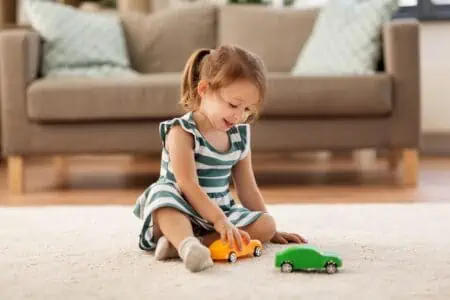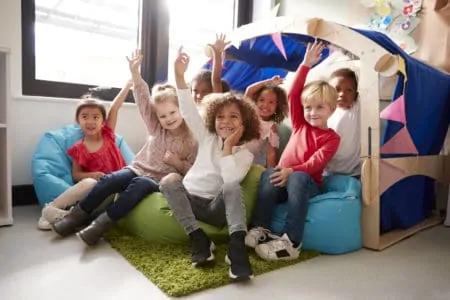We gathered 40 fascinating toddler facts and statistics to help you decode this brilliant, exhausting stage. From language explosions to motor skills, here is everything you need to know about your little one’s development.
Key Toddler Facts and Statistics
- Rapid mobility: Between 12 and 36 months, children progress from standing to jumping and riding tricycles.
- Language explosion: Most toddlers can string two words together by age two and possess a vocabulary of 200 words by age three.
- Sleep disruptors: Blue light from screens suppresses melatonin, which often leads to fighting bedtime and poor sleep quality.
- Potty training window: The average age for toilet training in the U.S. falls between two and three years old.
Toddler Milestone Checklist
Monitoring development is part of the parenting gig. It ensures your little one is on the right track. However, remember that development is a curve, not a straight line. Every child finds their footing at a different pace.
If you have genuine concerns about missed milestones, always chat with your pediatrician. Use this checklist, based on psychological and medical research, as a general guide.
12 to 18 Months
- Takes those wobbly first steps.
- Vocals include three to five clear words.
- Uses gestures like waving goodbye.
- Hunts for objects you hide (object permanence).
- Engages in social play, like Peekaboo.
- Identifies parents as “Mama” or “Dada.”
- Understands and reacts to the word “no.”
- Drops objects into containers.
- Drinks from a cup (with a little help).
- Uses a pincer grip (thumb and forefinger) to grab small items.
- Stacks blocks or objects.
- Follows a recognizable sleep pattern.
- Tries a variety of solid foods.
- Follows one-step directions.
- Points to at least one body part when asked.
- Understands roughly 50 words comfortably.
18 to 24 Months
- Attempts new words regularly.
- Grasps pronouns like “me” or “mine.”
- Identifies five specific body parts.
- Connects two words (e.g., “Mommy go”).
- Follows two-step commands (e.g., “Find your shoes and bring them here”).
- Enjoys listening to short stories.
- Walks without assistance.
- Attempts to use forks and spoons.
- Points to get your attention.
- Assists with dressing (pushes arm through sleeve).
- Mimics your household chores.
- Uses toys for their intended purpose (phone to ear).
- Navigates furniture by climbing.
- Starts to run.
- Throws tantrums when frustrated.
- Shows stranger anxiety.
- Displays affection to family members.
- Shakes head to signal “no.”
- Engages with dolls or stuffed animals.
24 to 30 Months
- Shows empathy when others are sad.
- Gauges your facial expressions.
- Points to objects on command.
- Strings two to four words together.
- Copies mannerisms of adults and older kids.
- Blows kisses or uses complex gestures.
- Fiddles with buttons, knobs, and switches.
- Manages multiple toys simultaneously.
- Asserts independence firmly.
- Kicks a ball forward.
- Understands about 50 percent of what you say.
- Runs with better coordination.
- Navigates stairs with supervision.
- Identifies pictures in books.
- Names familiar people correctly.
- Sorts items by shape or color.
- Stacks four or more blocks.
- Balances on tiptoes.
- Uses prepositions like “in” and “on.”
- Turns book pages singly or in bunches.
- Refers to self by name.
30 to 36 Months
- Begins playing with other kids, not just near them.
- Demands attention (“Look at me!”).
- Follows routine instructions easily.
- Vocabulary hits around 50 spoken words (often more).
- Constructs 3-4 word sentences.
- Engages in imaginative pretend play.
- Climbs jungle gyms or furniture well.
- Pedals a tricycle.
- Offers affection without being asked.
- Solves simple problems (using a stool to reach).
- Completes 3-4 piece puzzles.
- Builds towers of six+ blocks.
- Names at least one color correctly.
- Operates door handles and jar lids.
- Undresses partially without help.
- Jumps with two feet off the ground.
- Shows concern for crying friends.
- Separates from parents more easily.
- Notices subtle changes in routine.
- Holds crayons with fingers rather than a fist.
- States name, age, and gender.
- Uses pronouns (I, me, we, you).
- Speech is mostly understandable to strangers.
- Asks the “Big Three” questions: Who, Why, Where.
- Uses plurals (cats, dogs).
- Understands simple sentences fully.
- Begins or completes potty training.
Three to Four Years
- Recovers quickly after drop-offs.
- Seek out playmates.
- Sustains back-and-forth conversation.
- Asks “who, what, where, why” constantly.
- Describes actions happening in pictures.
- Hops on one foot briefly.
- Navigates stairs independently (alternating feet).
- Throws a ball overhand.
- Draws simple shapes (circle, square).
- Uses safety scissors.
- Speaks in sentences of 3+ words consistently.
- Tells simple stories.
- Identifies several colors.
- Grasps the concept of time (morning vs. night).
- Engages in role-play (teacher, doctor).
- Negotiates with parents or peers.
- Recognizes common dangers (hot stove).
- Strings beads onto a lace.
- Dresses with minimal assistance.
40 Fun Facts About Your Toddler
Technically, a toddler is just a tiny human between one and three years old who “toddles.” But if you live with one, you know they are much more than that definition implies. They are energetic, emotional, and hilarious scientists testing the laws of physics daily. Here are 40 facts about these fascinating little people.
Development Stages and Milestones
The physical and emotional leaps that happen between age one and three are staggering. It is a unique kind of magic to witness.
- Gross motor explosion: Between 12 and 36 months, toddlers master standing, walking backward, jumping, and riding a tricycle (1). Check out these gross motor activities to help them along.
- Dexterity improves: Fine motor skills skyrocket. By 24 months, they can stack items, manipulate spoons, and attempt to draw circles.
- Problem solvers: Around age two, cognitive skills sharpen. They can find objects hidden under multiple layers, sort colors, and follow multi-step instructions.
- Watch for regression: If a toddler stops pointing, doesn’t copy others, or loses skills they previously mastered, consult a healthcare provider immediately (2).
- Big feelings: The second year brings intense emotions, ranging from pure joy to blinding rage (3). Naming these feelings helps them regulate.
- The independence paradox: Two-year-olds crave independence, which causes tantrums when they can’t do things themselves. Offering simple choices (red shirt or blue shirt?) can reduce these meltdowns.
- Language markers: By age two, they should point to things you name and recognize familiar faces (4).
- Table manners start now: Though messy, a toddler should be able to chew with full jaw movements and navigate a fork and spoon.
Language Skills and Social Development
Language acquisition is one of the most exciting parts of the toddler years. They go from babbling to negotiating remarkably fast.
- The naming game: Between 12 and 24 months, toddlers learn nouns first, followed by verbs, and finally adjectives (5).
- Context clues: First words are usually things they see daily. “Duck” might appear if they love bath time, or “dog” if you have a pet.
- Self-referencing: Around 18 months, many toddlers learn their own name and refer to themselves in the third person. It is undeniably cute.
- Word explosion: Between ages two and three, vocabulary expands to include location words (in, under) and pronouns (6).
- Phrase building: Two-year-olds typically string two words together (“Blue car”). By three, they are building proper sentences.
- By the numbers: A 24-month-old links two words. A 30-month-old has roughly 50 words. By 36 months, that vocabulary likely exceeds 200 words (7).
- Speech red flags: If a three-year-old has fewer than 50 words or cannot name familiar objects, it is time to check in with a doctor for a potential speech or hearing evaluation.
- Articulation issues: It is normal for three-year-olds to struggle with tricky sounds like “v,” “ch,” and “th.”
Screen Time and Technology
Screens are a modern parenting reality. While they offer a break for tired parents, we need to balance the digital babysitter with healthy development.
- Unsupervised risks: Without supervision, toddlers can stumble upon inappropriate content or confusing ads (8). Vetting content is crucial.
- The melatonin thief: Blue light interferes with the sleep-wake cycle (9). Evening screen time suppresses melatonin twice as much in kids as in adults. If your toddler isn’t sleeping well, check the iPad usage.
- Sedentary habits: Increased screen time correlates with higher obesity risks (10). Electronics in the bedroom amplify this risk.
- Behavioral links: Excessive screen time (2+ hours daily) is linked to attention problems and social issues.
- Under 18 months: The AAP recommends avoiding screens entirely for children under 18 months, except for video chatting (11). For older toddlers, stick to high-quality programs like Sesame Street and watch with them.
- Missed movement: Toddlers learn by moving. Time spent swiping a screen is time not spent running, climbing, or developing motor skills.
- Literacy trade-off: High screen use is linked to less interest in reading (12). Every 10-minute drop in reading time at age three correlated with increased screen usage by age five.
- Aggression connection: Studies suggest a link between high screen time in infancy (6-18 months) and higher emotional reactivity later on (13).
Toilet Training Facts
Potty training is a massive milestone that often feels like a regression to the newborn days of mess and stress. Here is the lowdown on ditching the diapers.
- The U.S. average: Most American children toilet train between two and three years old (14).
- Too early can backfire: Training before 27 months often takes longer. Toddlers starting between 18-24 months took roughly 13 months to finish, while those starting after 27 months finished in about 10 months (15).
- Too late has risks: Conversely, waiting until after 32 months can sometimes lead to more resistance and accidents.
- The sweet spot: Research suggests the “goldilocks” window for training is between 27 and 32 months (16). However, follow your child’s lead, not the calendar.
- Cultural differences: Timing varies by culture and demographics. For example, some data shows Black parents often begin training earlier (around 19 months) compared to White parents (around 25 months).
- Readiness signs: Look for dry diapers after naps, the ability to follow instructions, and physical indicators like hiding to poop.
- Physiological limits: You can’t train a body that isn’t ready. Children typically don’t have the muscle control to “hold it” until at least 12 to 18 months.
- Methods vary: From the gentle Brazelton approach to the intensive “Boot Camp” methods, there is no single right way to train. Pick what fits your family.
Early Education and Child Care
With parental leave being limited in the U.S., many toddlers enter early education programs. Here is how that impacts them.
- Enrollment numbers: Roughly 66 percent of preschool-aged children attend early education programs (17). This is a massive jump from just 37 percent in 1970.
- Public vs. private: Attendance in public programs has nearly doubled since the 70s, now accounting for about 46 percent of children.
- Longer days: Full-day childcare is now the norm, with 65 percent of toddlers attending full-day sessions compared to 17 percent decades ago.
- Pandemic dip: COVID-19 impacted enrollment significantly, dropping preschool participation from 51 percent down to roughly 42 percent (18).
- College correlation: Attending early education by age four is linked to higher college attendance rates later in life (19).
- Test scores: Interestingly, there is no strong correlation between preschool attendance and higher standardized test scores later in elementary school.
- Types of care: Most children (62 percent) attend center-based care (daycare/preschool), while about 38 percent are cared for by relatives or nannies (20).
- Social trade-offs: Center-based care is linked to better cognitive and language skills by age three (21). However, some studies note slightly higher behavioral challenges by age 4.5 in these environments compared to home care.









